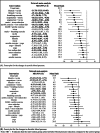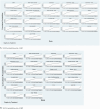An updated network meta-analysis of non-pharmacological interventions for primary hypertension in adults: insights from recent studies
- PMID: 39736688
- PMCID: PMC11686877
- DOI: 10.1186/s13643-024-02744-5
An updated network meta-analysis of non-pharmacological interventions for primary hypertension in adults: insights from recent studies
Abstract
Background: Primary hypertension significantly impacts global cardiovascular health, contributing to increased mortality rates and posing a substantial public health challenge. Recognizing the growing evidence supporting non-pharmacological interventions (NPIs) for controlling primary hypertension, our study employs Network Meta-Analysis (NMA) to comprehensively assess their efficacy.
Methods: This review updates a prior systematic review by searching for original literature on NPIs for primary hypertension from 2013 to 2024. We conducted a thorough search in eight databases, including PubMed, Embase, Web of Science, Cochrane Central Register of Controlled Trials, Allied and Complementary Medicine Database, CNKI, WanFang Data, and Chongqing VIP, identifying potential randomized controlled trials (RCTs) from January 1, 2013, to August 1, 2024. Primary outcomes included the mean changes in blood pressure before and after treatment. Analysis was performed using GeMTC package (R 4.2.3), and Stata 17.0. The confidence of evidence was examined using Confidence in Network Meta-Analysis (CINeMA).
Results: Utilizing NMA, we reviewed 9,189 studies, identifying 54 eligible articles with 5,827 participants. Investigating 22 distinct NPIs, the focus was on changes in systolic and diastolic blood pressure pre and post-treatment. Lifestyle intervention + Tai Chi significantly reduced systolic (-21.75 mm Hg; 95% CI -33.25 to -10.02) and diastolic blood pressure (-13.62 mm Hg; 95% CI -23.14 to -3.71) compared to usual care and other NPIs. Consistency and regression analyses did not reveal significant differences.
Conclusion: This review provides a comprehensive evaluation of NPIs for primary hypertension, emphasizing lifestyle + Tai Chi as a preferred NPI. Breathing exercises show potential in lowering systolic blood pressure, and acupuncture + tui na demonstrates effectiveness in reducing diastolic blood pressure, outperforming other interventions. The study reinforces the role of NPIs in managing primary hypertension, providing a foundation for future hypertension research.
Keywords: Lifestyle; Network meta-analysis; Non-pharmacological interventions; Primary hypertension; Review.
© 2024. The Author(s).
Conflict of interest statement
Declarations. Ethics approval and consent to participate: Not applicable. Consent for publication: Not applicable. Competing interests: The authors declare that they have no competing interests.
Figures





Similar articles
-
Systemic pharmacological treatments for chronic plaque psoriasis: a network meta-analysis.Cochrane Database Syst Rev. 2021 Apr 19;4(4):CD011535. doi: 10.1002/14651858.CD011535.pub4. Cochrane Database Syst Rev. 2021. Update in: Cochrane Database Syst Rev. 2022 May 23;5:CD011535. doi: 10.1002/14651858.CD011535.pub5. PMID: 33871055 Free PMC article. Updated.
-
Long-term effects of weight-reducing diets in people with hypertension.Cochrane Database Syst Rev. 2016 Mar 2;3(3):CD008274. doi: 10.1002/14651858.CD008274.pub3. Cochrane Database Syst Rev. 2016. Update in: Cochrane Database Syst Rev. 2021 Feb 8;2:CD008274. doi: 10.1002/14651858.CD008274.pub4. PMID: 26934541 Free PMC article. Updated.
-
Systemic pharmacological treatments for chronic plaque psoriasis: a network meta-analysis.Cochrane Database Syst Rev. 2017 Dec 22;12(12):CD011535. doi: 10.1002/14651858.CD011535.pub2. Cochrane Database Syst Rev. 2017. Update in: Cochrane Database Syst Rev. 2020 Jan 9;1:CD011535. doi: 10.1002/14651858.CD011535.pub3. PMID: 29271481 Free PMC article. Updated.
-
Interventions for central serous chorioretinopathy: a network meta-analysis.Cochrane Database Syst Rev. 2025 Jun 16;6(6):CD011841. doi: 10.1002/14651858.CD011841.pub3. Cochrane Database Syst Rev. 2025. PMID: 40522203
-
Replacing salt with low-sodium salt substitutes (LSSS) for cardiovascular health in adults, children and pregnant women.Cochrane Database Syst Rev. 2022 Aug 10;8(8):CD015207. doi: 10.1002/14651858.CD015207. Cochrane Database Syst Rev. 2022. PMID: 35944931 Free PMC article.
Cited by
-
The Existing Interventions to Promote Self-Care and Self-Monitoring Preventing Hypertension Among Thai Risk People: A Scoping Review.Vasc Health Risk Manag. 2025 Jul 9;21:519-544. doi: 10.2147/VHRM.S521564. eCollection 2025. Vasc Health Risk Manag. 2025. PMID: 40661694 Free PMC article.
-
Effects of different exercise modalities on blood pressure and endothelial function in prehypertension individuals: a systematic review and network meta-analysis.Front Cardiovasc Med. 2025 Jun 25;12:1550435. doi: 10.3389/fcvm.2025.1550435. eCollection 2025. Front Cardiovasc Med. 2025. PMID: 40636824 Free PMC article.
References
-
- Semsarian C, Ingles J, Maron MS, Maron BJ. New perspectives on the prevalence of hypertrophic cardiomyopathy. J Am Coll Cardiol. 2015;65(12):1249–54. - PubMed
-
- Global, regional, and national comparative risk assessment of 84 behavioural, environmental and occupational, and metabolic risks or clusters of risks for 195 countries and territories, 1990–2017: a systematic analysis for the Global Burden of Disease Study 2017. Lancet (London, England). 2018; 392(10159):1923–1994. - PMC - PubMed
-
- Kearney PM, Whelton M, Reynolds K, Muntner P, Whelton PK, He J. Global burden of hypertension: analysis of worldwide data. Lancet (London, England). 2005;365(9455):217–23. - PubMed
Publication types
MeSH terms
Grants and funding
- 82060900/National Natural Science Foundation of China
- 202305AF150072/"Liang Fanrong Expert Workstation" of Yunnan Province - Yunnan Provincial Science and Technology Plan Project
- YNWR-QNBJ-2019-257/Youth Special of Yunnan Province Ten-thousand Plan
- U21A20404/National Natural Science Foundation of China Regional Innovation and Development Joint Fund
LinkOut - more resources
Full Text Sources

